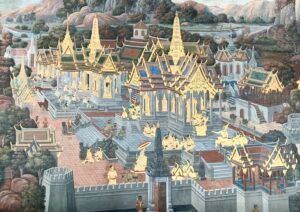Thailand’s art scene is a vibrant tapestry that weaves together centuries-old traditions with contemporary innovations. Rooted in a rich cultural heritage, Thai art reflects a unique blend of influences from India, China, Cambodia, and the West. In this article, we’ll explore the multifaceted world of Thai art, from its historical origins to the modern-day expressions that captivate audiences worldwide.
Cultural Heritage and Influences
Thailand’s cultural heritage is deeply intertwined with its art forms. From intricate temple murals to avant-garde installations, Thai artists draw inspiration from their surroundings, history, and spirituality. Let’s delve into the key aspects:
- Blend of Influences: Thai art is a melting pot of diverse influences. Ancient Khmer art from neighboring Cambodia, Indian aesthetics, and Chinese techniques have all contributed to its evolution. Additionally, Western art forms arrived during the 19th century, further enriching the creative landscape.
- Religious and Historical Context: Art has played a pivotal role in Thai society. Temples (known as “wats”) are adorned with exquisite murals depicting Buddhist stories, celestial beings, and mythical creatures. Royal palaces also feature intricate carvings and sculptures, showcasing the artistic prowess of Thai craftsmen.
Historical Background of Thai Art
Traditional Forms
- Classical Painting: Traditional Thai painting often graces temple walls and manuscripts. Artists use vivid colors and intricate detailing to depict religious narratives and historical events.
- Sculpture: Thai sculpture ranges from serene Buddha statues to mythical creatures like the half-bird, half-human “kinnari.” These sculptures adorn temples and public spaces.
- Crafts: Thai crafts include silk weaving, lacquerware, and pottery. Silk production, especially in regions like Isaan, produces exquisite textiles with intricate patterns.
Modern Thai Art Movement
Fusion of East and West
- 19th Century Influence: The arrival of Western artists and art schools in the 19th century sparked a revolution. Thai artists began experimenting with oil painting, perspective, and realism.
- Prominent Artists:
- Montien Boonma: Known for his thought-provoking installations, Montien blended traditional Thai materials with contemporary concepts.
- Araya Rasdjarmrearnsook: A video artist, Araya explores themes of mortality, identity, and cultural memory.

Contemporary Art and Global Influence
Breaking Boundaries
- Digital Art: Thai artists embrace technology, creating digital paintings, animations, and interactive installations. Social media platforms serve as virtual galleries.
- Street Art: Bangkok’s streets come alive with colorful murals, graffiti, and stencil art. Artists use public spaces to convey social messages and provoke thought.
- Experimental Media: Performance art, multimedia installations, and conceptual pieces challenge conventions. Thai artists engage with global issues, including environmental concerns and social justice.
Art Venues and Events
Where Creativity Thrives
- Bangkok Art and Culture Centre (BACC): Located in the heart of Bangkok, BACC hosts exhibitions, workshops, and performances. It’s a hub for contemporary art enthusiasts.
- Museum of Contemporary Art (MOCA): Situated in Chatuchak, MOCA houses an impressive collection of Thai and international contemporary art.
- Bangkok Art Biennale: This biennial event brings together artists from around the world, transforming the city into a canvas of creativity.

Thailand’s art scene continues to evolve, bridging the gap between tradition and innovation. Whether you’re exploring ancient temples or attending a cutting-edge exhibition, Thai art invites you to experience its rich legacy and dynamic present. 🎨🌟






